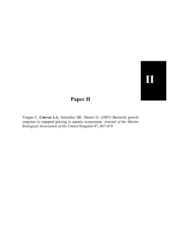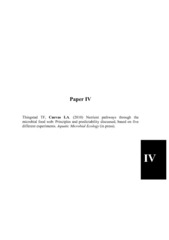| dc.contributor.author | Cuevas, Luis Antonio | eng |
| dc.date.accessioned | 2011-02-04T13:29:29Z | |
| dc.date.available | 2011-02-04T13:29:29Z | |
| dc.date.issued | 2010-12-14 | eng |
| dc.identifier.isbn | 978-82-308-1670-7 (print version) | en_US |
| dc.identifier.uri | https://hdl.handle.net/1956/4472 | |
| dc.description.abstract | To understand (1) the role of heterotrophic bacteria in the biogeochemical cycles, (2) the fate of the organic carbon and mineral nutrients, and (3) the flow of energy to higher trophic levels, we need to understand how bacterial growth is controlled in marine environments. The main hypotheses about the control of bacterial growth are based on the studies about bottomup control (limiting resources) and top-down control (predators and viruses), that is, how bacteria interact with their ‘neighbors’ in the microbial food web. Using micro- and mesocosm experiments, comparative analyses, plus an idealized model to test different predictions, this thesis evaluates the role of heterotrophic bacteria in the utilization of organic matter in different marine environments. The effects of mineral nutrients, organic carbon and predator control over bacterial growth are also investigated. Bacterial growth rates can be controlled by carbon or/and mineral nutrients depending on the biological oceanographic conditions (Papers I and II). Both types of bacterial growth limitation (carbon and mineral nutrient) can co-exist simultaneously depending on the structure of the microbial food web, mineral nutrient and labile organic carbon concentration. Dominance of nano-phytoplankton, which can be grazed by rapidly responding micro-zooplankton (e.g. idealized model in Paper IV), will shifts more rapidly to a carbon limited bacterial growth, thus, heterotrophic bacteria may use all labile organic carbon preventing its accumulation in the euphotic zone (Paper I). Contrary, dominance of large diatoms, which can be grazed by slowly responding copepods, can keep labile organic carbon produced by copepod (e.g. sloppy feeding) and bacterial growth can be limited by mineral nutrients (i.e. competition of nutrients with diatoms) (Paper II) shifting the system slowly to carbon limited bacterial growth control. Different rates of organic carbon utilization by bacteria can be estimated in manipulated mesocosm experiments by adding mineral nutrients (i.e. silicate, ammonium and nitrate) and by the effect of supply ratios of glucose-C to mineral nutrients ratio. Total organic carbon accumulation rates are influenced by the dominant phytoplankton communities and by the availability of glucose for bacteria and phosphate for bacteria and phytoplankton. Low availability of mineral nutrients can reduce the bacterial capacity to consume degradable organic carbon (Paper III). Investigating the effect of carbon and mineral nutrients on the fate of organic carbon, it seems possible to explain the responses of the system using a ‘simplest possible’ idealized food web model (Paper IV). Thus, different system attributes (e.g. flexible stoichiometry and predatory processes), can affect the dominant nutrient pathway and speed the nutrients transfer in different cases (Paper IV). In a global perspective, the variation in the slope (k) and the intercept (β) of the relationship between bacterial productivity and biomass can change observing contrasting trophic ocean basins. Variation in these two parameters (k and β) implies an effect on bacterial growth rates across a gradient of productivity (Paper V). Using micro- and mesocosm experiments as well as comparative analyses, can be possible to improve our understanding on the role of heterotrophic bacteria by adding ad hoc assumptions to the basic model structure and by looking the global regulation on bacterial growth. Is also necessary to take in account that several aspects complicate the idealized view of the microbial food web, being an enormous task to keep a minimum of interactions to produce a simple conceptual model with prediction power. | en_US |
| dc.language.iso | eng | eng |
| dc.publisher | The University of Bergen | en_US |
| dc.relation.haspart | Paper I: Polar Biology, Cuevas, L. A.; Egge, J. K.; Thingstad, T. F.; Töpper, B., Organic carbon and mineral nutrients limitation of oxygen consumption, bacterial growth and efficiency in the Norwegian Sea. Accepted version. Copyright 2011 The Authors. The published version is available on the publisher’s webpage: <a href="http://dx.doi.org/10.1007/s00300-010-0944-3" target="blank">http://dx.doi.org/10.1007/s00300-010-0944-3</a > | en_US |
| dc.relation.haspart | Paper II: Journal of the Marine Biological Association of the United Kingdom 87(3), Vargas, C.; Cuevas, L. A.; González, H. E.; Daneri, G., Bacterial growth response to copepod grazing in aquatic ecosystems, pp. 667-674. Published version. Copyright 2007 Marine Biological Association of the United Kingdom. Published by Cambridge University Press. The published version is also available at: <a href="http://dx.doi.org/10.1017/S0025315407056275" target="blank"> http://dx.doi.org/10.1017/S0025315407056275</a> | en_US |
| dc.relation.haspart | Paper III: Cuevas, L. A.; Tanaka, T.; Thingstad, T. F.; Børsheim, K. Y.; Egge, J.; Skjoldal, E. F.; Thyrhaug, R.; Töpper, B., (2010), Effect of supply ratios of glucose-C to mineral nutrients on availability of glucose for bacteria and of phosphate for phytoplankton and bacteria for two arctic mesocosm experiments. Draft version. Full text not available in BORA. | en_US |
| dc.relation.haspart | Paper IV: Aquatic Microbial Ecology 61, Thingstad, T. F.; Cuevas, L. A., Nutrient pathways through the microbial food web: Principles and predictability discussed, based on five different experiments, pp. 249-260. Published version. Copyright 2010 Inter-Research. Reproduced with permission. | en_US |
| dc.relation.haspart | Paper V: Cuevas, L. A.; Thingstad, T. F., (2010), Global patterns of bacterioplankton dynamics: Relationship between bacterial biomass and production in open ocean regions. Draft version. Full text not available in BORA. | en_US |
| dc.title | Bacterial growth control in marine environments : from experimental approaches to comparative analyses | en_US |
| dc.type | Doctoral thesis | |
| dc.rights.holder | The author. | en_US |
| dc.rights.holder | Copyright the author. All rights reserved | en_US |
| dc.subject.nsi | VDP::Mathematics and natural science: 400::Basic biosciences: 470::Biochemistry: 476 | en_US |



